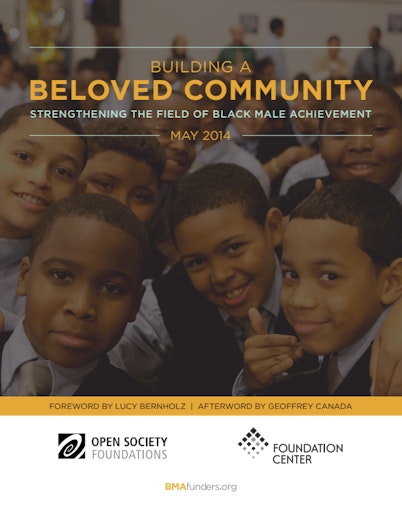How Do You Quantify Hope for Black Men and Boys?
By Shawn Dove
How do you quantify hope? I’ve been asking myself this question recently in my role leading the Open Society Campaign for Black Male Achievement. The question increasingly presses on my heart and mind during this current moment of intensified focus on the disparities facing black men and boys in America, particularly with the increased demand for evidenced-based outcomes and for lifting up what truly works.
I come in contact with leaders, young and old, every day working hard to fuel the field of black male achievement, who give me hope that lasting change is possible. This week, the Foundation Center and their BMAfunders team published a report that should provide the nation with a recipe for quantifying hope for black men and boys.
Building a Beloved Community: Strengthening the Field of Black Male Achievement is a timely resource in light of a growing chorus of national initiatives focused on improving the life outcomes of black males. Based on interviews with 50 leaders in the social, academic, government, and business sectors, Building a Beloved Community maps the landscape of work in black male achievement and offers recommendations for what it will take to strengthen the field moving forward.
The report attempts to answer the question posed in the title of its 2012 companion report, Where Do We Go From Here? Philanthropic Support for Black Men and Boys. It declares that we need to go where Dr. Martin Luther King, Jr. described a generation ago as the Beloved Community—a nation fulfilling the pledge of its founding promise of “justice for all.”
About the Beloved Community, King said “we are tied together in the single garment of destiny, caught in an inescapable network of mutuality.” This notion is linked to scholar and civil rights activist Lani Guinier’s premise that black men and boys are America’s “canaries in the mine”—that the inequities they face are inextricably connected to all citizens. In fact, it was Guinier’s premise that helped convince the Open Society U.S. Programs board of directors to launch the Campaign for Black Male Achievement in 2008. Since then, we have worked with countless partners to help catalyze the emerging leaders and organizations that are depicted in the Building a Beloved Community report.
We at the campaign are thrilled to have the Foundation Center as one of our core research partners over the years. Seema Shah and Grace Sato have leaned into this mission to produce groundbreaking reports like Building a Beloved Community and launch BMAfunders.org, the central repository for all things black male achievement.
With the recent announcement of the White House’s My Brother’s Keeper Initiative, increased philanthropic engagement through the Executives’ Alliance to Expand Opportunities for Boys and Men of Color, and a groundswell of attention to this issue, there is an opportunity for change that must be pursued with a sense of urgency.
But as Darren Walker, CEO of the Ford Foundation, notes in the report, what is needed to effectively respond to this moment is “bold, courageous leadership.” And I believe that is one way to quantify hope for the field of black male achievement: supporting the many bold, courageous leaders across sectors who are working to improve the life outcomes for black men and boys. Building a Beloved Community provides us with glimpses of many such leaders.
While this report has generated a good deal of activity in just the first days of its release, the overriding message woven through it is that we must not confuse activity with progress. We have an opportunity to maximize this opportunity into lasting change.
Geoff Canada, CEO of the Harlem Children’s Zone and one of the Open Society board members who helped launch the Campaign for Black Male Achievement, reminds us in the report’s afterword that "the barriers to success that black men face have been in plain sight for decades, so it is particularly heartening to see a movement taking shape that is specifically crafted to address these challenges and change the odds for one of the most disenfranchised populations in America. We are moving in the right direction, but we need to keep in mind that our commitment must be for the long haul." Canada’s words remind us that when it comes to the field of black male achievement, we are the leaders that we’ve been waiting for.
How do you quantify hope for black men and boys? Share your thoughts below.
Until February 2015, Shawn Dove was manager of the Open Society Campaign for Black Male Achievement.
